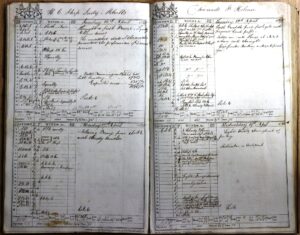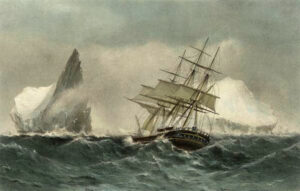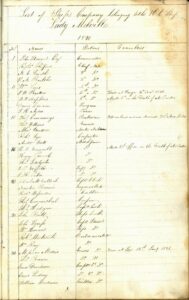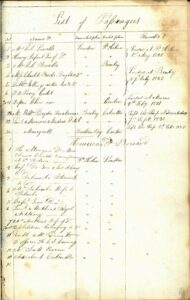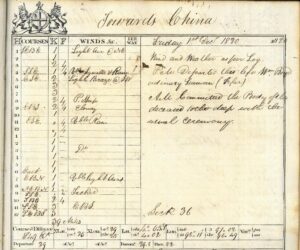This remarkable volume is held at the Council Archives as part of the Stirling Burgh collection. It is not clear why this record ended up being held by the Council, possibly one of the Georgian Council members had connections with the East India Company. Whatever its origins, the log book offers a fascinating insight into the day to day life of a merchant vessel in the early nineteenth century.
The East India Company was an extremely powerful organisation that effectively governed large parts of the Indian sub-continent in the eighteenth and early nineteenth centuries. Founded in 1600, the initial aim of the company was to create a trading monopoly in what was known at the time as the East Indies, the modern day Indian sub-continent and Southeast Asia. The Company became a behemoth, not only concerned with operating its large fleet of merchant shipping but also maintaining a large private army in order to influence the internal structures of government and take significant political power. You can read more about the Company here.
The ‘Lady Melville’ was built by Wells. Wigram and Green at Blackwall in 1813. She was used as a trading vessel by the Honourable East India Company until 1834, when she was sold to be broken up. You can read more about the ship here.
The beginning of this record gives a list of the entire ship’s company, which was comprised of 138 people, including soldiers and their wives. Every member of the crew has an entry along with their rank. Details of any casualties are also given. Twelve of the ship’s crew died on the voyage. Two were lost overboard, the other ten died of sickness, which appears to have been brought on to the vessel in November 1820 and spread thereafter like wildfire. Ship’s quarters were cramped and conditions insanitary, any infection brought on board would be passed on to other crew members very quickly. On 10th August 1821, a son was born to Mary Smith, wife of William Smith of the Royal Artillery.
There is also a list of all the passengers, both on the outward and return journeys. There were twenty four outward bound passengers and thirteen homeward bound passengers from St Helena. The ship left England from Gravesend in March 1820, went to St Helena, then Bombay and Calcutta, as they were known then, and then on to China. The prejudices of the time are amply illustrated in the passenger list. All the Europeans are given by name, but one entry simply reads ’15 Chinamen’. Clearly these individuals were not regarded as important enough to be accorded the respect of being listed by name.
Interestingly, on the return journey, the first name on the passenger list is that of the Marquis de Montchenu. Claude-Marie-Henri de Montchenu was the French Commissioner at St Helena, sent there by the French Government to keep an eye on Napoleon Bonaparte, who had been exiled to the island in 1815. Napoleon died in May 1820, nine weeks before the Lady Melville arrived. It is likely that either the arrangements that had to be made after Bonaparte’s death took a while to organise, or that the Lady Melville was the first ship available at St Helena to take the Marquis and his retinue home.
The Sea Log begins on 5th March 1820 when the ship left England for St Helena. The voyage to St Helena took eight weeks, the ship anchoring at St Helena on 1st May 1820. The ship remained at St Helena for six weeks, leaving for Bombay (Mumbai) on 13th June. They arrived in Mumbai on 27th July, staying there for four weeks, and left for Bengal on 24th August, arriving at New Anchorage, not far from Kolkata on 6th September. The voyage to China commenced on 12th November, the ship arriving at Whampoa on 8th February 1821, having anchored at the ‘Batavia Roads’ off Western Australia for ten days in December. The ‘Lady Melville’ travelled most of the outward journey in company with another vessel of the line – the HC ‘Canning’, probably for protection. They telegraphed messages to one another and had a system of blue flares as another form of communication.
The homeward journey began on 27th March 1821. This time, the ship was accompanied by the ‘Marquis of Huntly’, which later became a convict ship. The ‘Lady Melville’ anchored in the ‘Anjier Roads’ off China for a few days in April, and arrived back in St Helena on 19th of July where the passengers were picked up. The final leg of the journey commenced on 30th July, the ship arriving back to British shores on 11th September.
The cargo that the ship was carrying was made up of mostly private trade but the East India Company did take out a quantity of iron from England to Mumbai. At Bengal, they uploaded ballast and received cotton, some of which was delivered in China. At Whampoa, they loaded teas to be taken home to England. China tea was a popular choice at this time making the tea a valuable cargo item.
